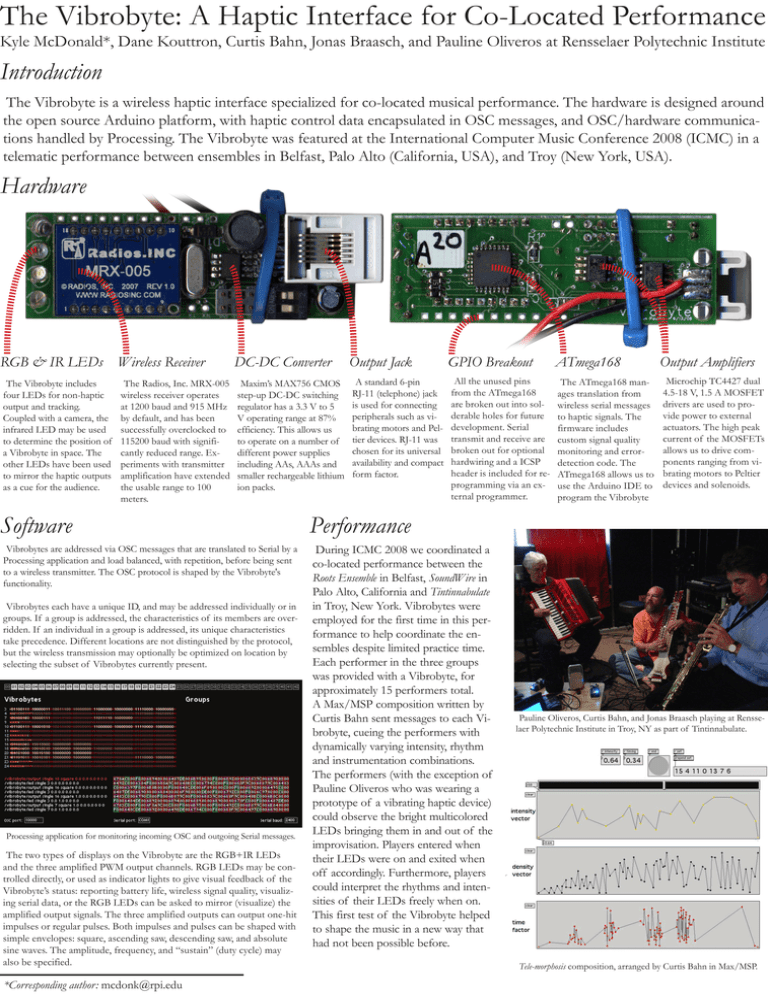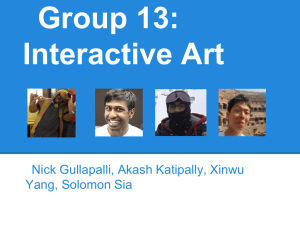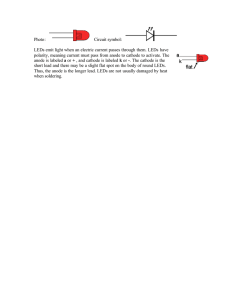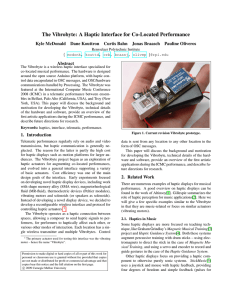NIME poster - Kyle McDonald
advertisement

The Vibrobyte: A Haptic Interface for Co-Located Performance Kyle McDonald*, Dane Kouttron, Curtis Bahn, Jonas Braasch, and Pauline Oliveros at Rensselaer Polytechnic Institute Introduction The Vibrobyte is a wireless haptic interface specialized for co-located musical performance. The hardware is designed around the open source Arduino platform, with haptic control data encapsulated in OSC messages, and OSC/hardware communications handled by Processing. The Vibrobyte was featured at the International Computer Music Conference 2008 (ICMC) in a telematic performance between ensembles in Belfast, Palo Alto (California, USA), and Troy (New York, USA). Hardware RGB & IR LEDs Wireless Receiver The Vibrobyte includes four LEDs for non-haptic output and tracking. Coupled with a camera, the infrared LED may be used to determine the position of a Vibrobyte in space. The other LEDs have been used to mirror the haptic outputs as a cue for the audience. The Radios, Inc. MRX-005 wireless receiver operates at 1200 baud and 915 MHz by default, and has been successfully overclocked to 115200 baud with significantly reduced range. Experiments with transmitter amplification have extended the usable range to 100 meters. DC-DC Converter Maxim’s MAX756 CMOS step-up DC-DC switching regulator has a 3.3 V to 5 V operating range at 87% efficiency. This allows us to operate on a number of different power supplies including AAs, AAAs and smaller rechargeable lithium ion packs. Software Vibrobytes are addressed via OSC messages that are translated to Serial by a Processing application and load balanced, with repetition, before being sent to a wireless transmitter. The OSC protocol is shaped by the Vibrobyte's functionality. Vibrobytes each have a unique ID, and may be addressed individually or in groups. If a group is addressed, the characteristics of its members are overridden. If an individual in a group is addressed, its unique characteristics take precedence. Different locations are not distinguished by the protocol, but the wireless transmission may optionally be optimized on location by selecting the subset of Vibrobytes currently present. Processing application for monitoring incoming OSC and outgoing Serial messages. The two types of displays on the Vibrobyte are the RGB+IR LEDs and the three amplified PWM output channels. RGB LEDs may be controlled directly, or used as indicator lights to give visual feedback of the Vibrobyte’s status: reporting battery life, wireless signal quality, visualizing serial data, or the RGB LEDs can be asked to mirror (visualize) the amplified output signals. The three amplified outputs can output one-hit impulses or regular pulses. Both impulses and pulses can be shaped with simple envelopes: square, ascending saw, descending saw, and absolute sine waves. The amplitude, frequency, and “sustain” (duty cycle) may also be specified. *Corresponding author: mcdonk@rpi.edu Output Jack A standard 6-pin RJ-11 (telephone) jack is used for connecting peripherals such as vibrating motors and Peltier devices. RJ-11 was chosen for its universal availability and compact form factor. GPIO Breakout All the unused pins from the ATmega168 are broken out into solderable holes for future development. Serial transmit and receive are broken out for optional hardwiring and a ICSP header is included for reprogramming via an external programmer. ATmega168 The ATmega168 manages translation from wireless serial messages to haptic signals. The firmware includes custom signal quality monitoring and errordetection code. The ATmega168 allows us to use the Arduino IDE to program the Vibrobyte Output Amplifiers Microchip TC4427 dual 4.5-18 V, 1.5 A MOSFET drivers are used to provide power to external actuators. The high peak current of the MOSFETs allows us to drive components ranging from vibrating motors to Peltier devices and solenoids. Performance During ICMC 2008 we coordinated a co-located performance between the Roots Ensemble in Belfast, SoundWire in Palo Alto, California and Tintinnabulate in Troy, New York. Vibrobytes were employed for the first time in this performance to help coordinate the ensembles despite limited practice time. Each performer in the three groups was provided with a Vibrobyte, for approximately 15 performers total. A Max/MSP composition written by Curtis Bahn sent messages to each Vibrobyte, cueing the performers with dynamically varying intensity, rhythm and instrumentation combinations. The performers (with the exception of Pauline Oliveros who was wearing a prototype of a vibrating haptic device) could observe the bright multicolored LEDs bringing them in and out of the improvisation. Players entered when their LEDs were on and exited when off accordingly. Furthermore, players could interpret the rhythms and intensities of their LEDs freely when on. This first test of the Vibrobyte helped to shape the music in a new way that had not been possible before. Pauline Oliveros, Curtis Bahn, and Jonas Braasch playing at Rensselaer Polytechnic Institute in Troy, NY as part of Tintinnabulate. Tele-morphosis composition, arranged by Curtis Bahn in Max/MSP.





